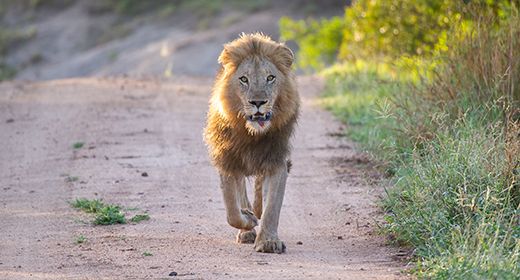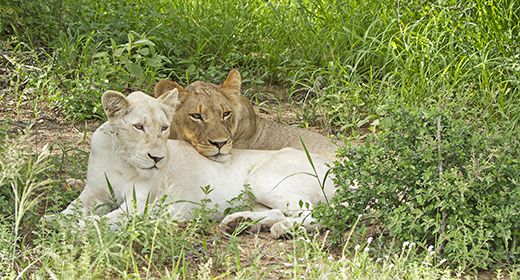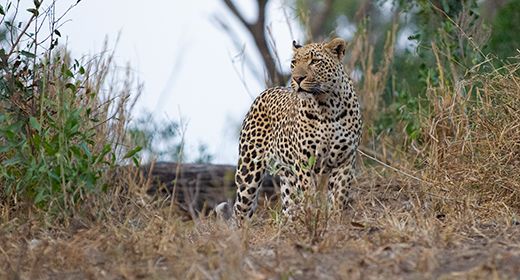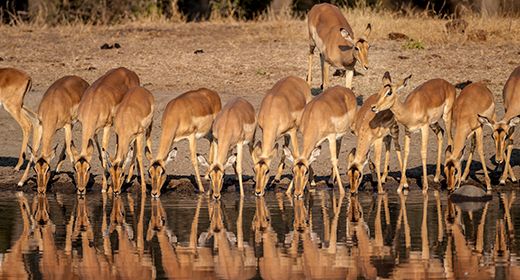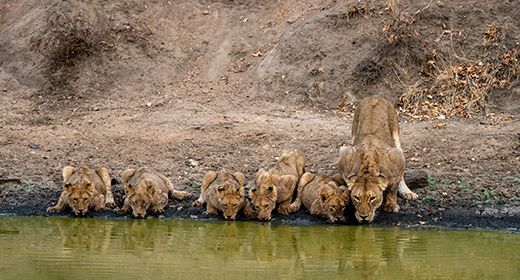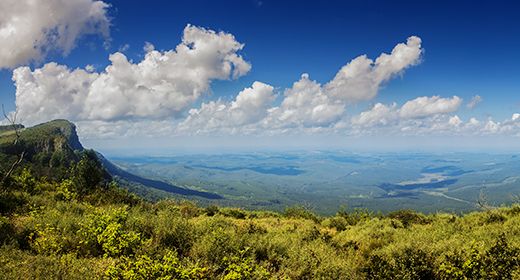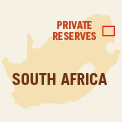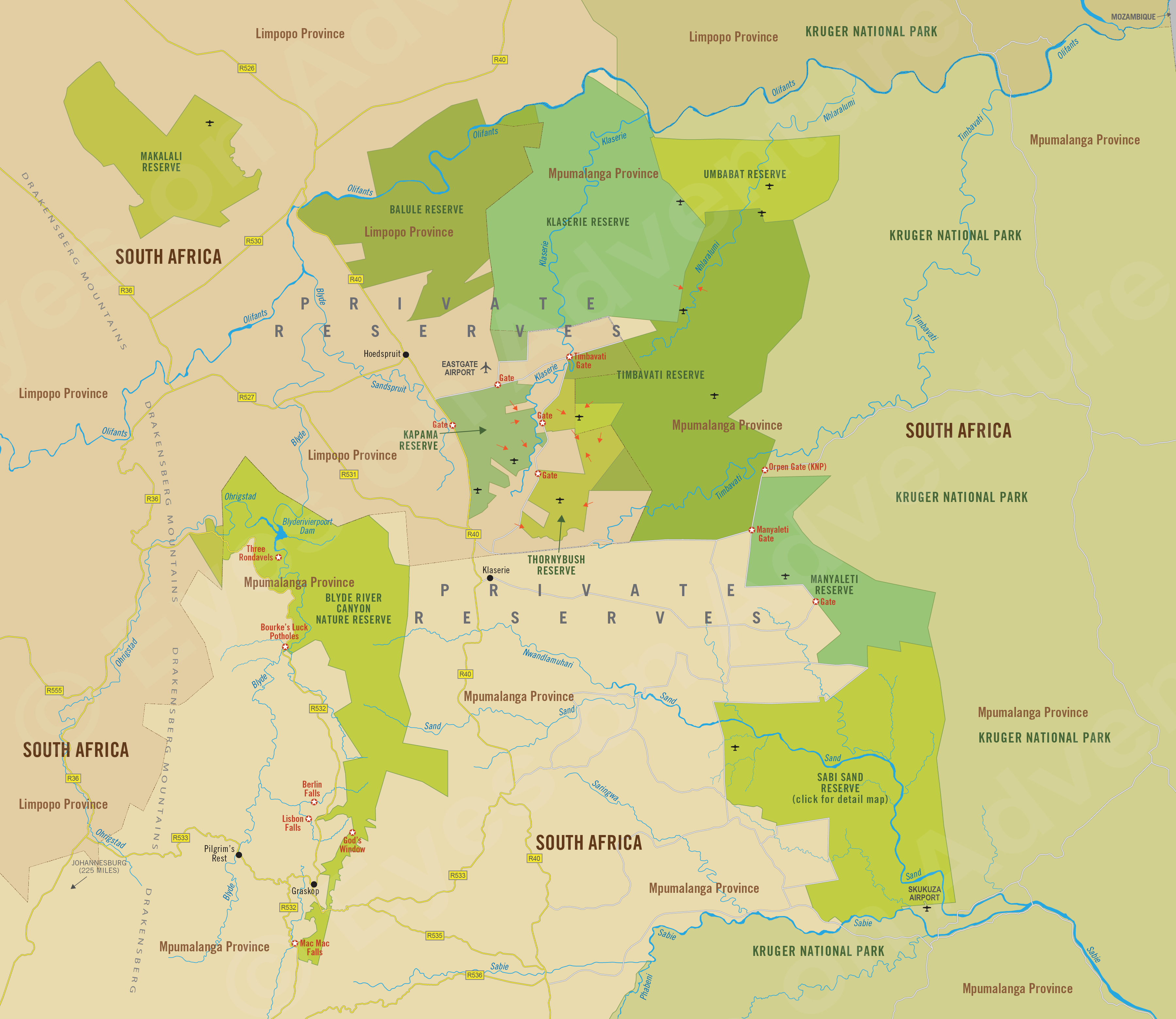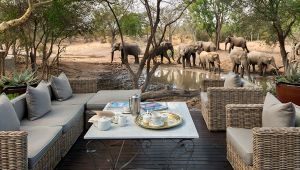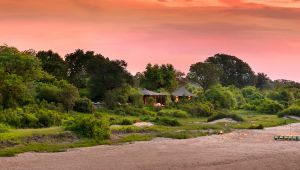Kruger Private Reserves
(incl. Sabi Sand, Timbavati, Manyaleti, Kapama, Thornybush, Makalali, Umbabat, Blyde River Canyon)
Region Links: Cape Peninsula, Cape Town, Cape West Coast, Cape Winelands, Eastern Cape, Garden Route, Gauteng Province, Johannesburg, Kruger Park & Lowveld, Kruger Private Reserves, KwaZulu-Natal, Madikwe, Overberg & Whale Coast, Pilanesberg & Sun City, Sabi Sand Reserve
Highlights
- Superb game viewing including Africa's Big Five animals
- The Sabi Sand Reserve is renowned as Africa's best leopard viewing destination
- Wildlife roams freely between most of the reserves and Kruger National Park
- Wide selection of safari camps and lodges at various price points
- Exclusive safari experience and excellent guiding
Located along the western side of South Africa's Kruger National Park are a number of private wildlife reserves. These reserves offer great wildlife viewing, including Africa's Big Five, excellent safari lodges, and superb guiding.
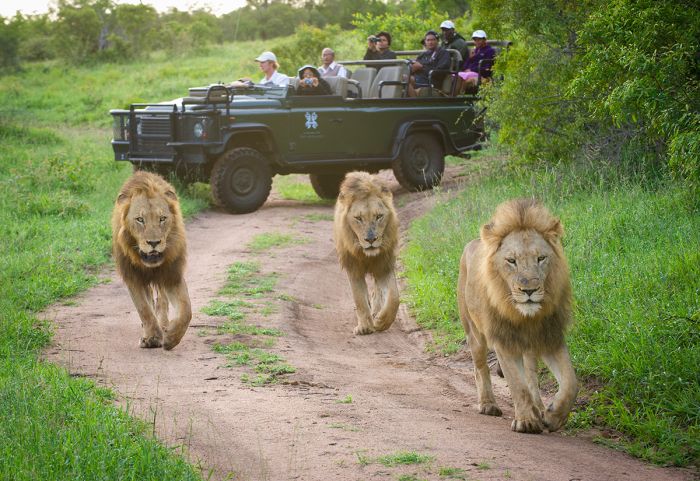
Lions in the Sabi Sand Reserve (Copyright © James Weis).
The Private Reserves include the renowned Sabi Sand Reserve, as well as the Timbavati, Manyaleti, Thornybush, Kapama, Umbabat, Klaserie, Makalali, and Balule reserves. The reserve are unfenced on their shared boundary with Kruger National Park (the fences were removed in 1993), allowing wildlife to move freely in a huge ecosystem that combines the massive national park with the private reserves.
Safaris in any of these private reserves are quite a different experience to a safari in Kruger National Park. Self-drivers, which are mainly what one will see in the national park, are prohibited in the private reserves and the crowds and paved roads in Kruger are nonexistent in the private reserves. The private reserve lodges and guiding are far superior to those in Kruger and off-road driving (to follow a lion or leopard for example) is prohibited in the national park, but is the norm for safaris in the reserves.
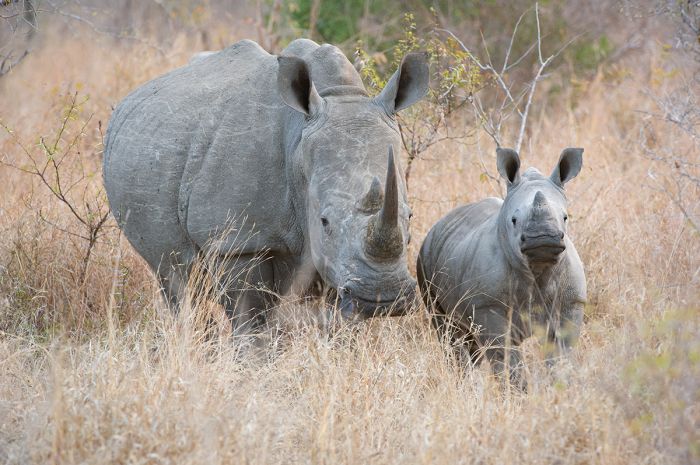
White rhino and calf in the Timbavati Reserve (Copyright © James Weis).
The formula for safaris at the safari camps and lodges in the reserves is twice daily game drives (one departing very early morning and returning for late brunch and another in the mid- to late-afternoon returning at dusk or extending into a night drive). Drives are conducted by a knowledgeable ranger and usually a local tracker on board to help spot animals. Snacks and drinks are on the safari vehicle, which is a customized and open 4WD Land Rover. Middays are spent at the camp. It's an addicting experience!
Various levels of luxury differentiate the safari lodges but all offer a superb safari experience, with nearly non-stop wildlife viewing, including lion, leopard, elephant, buffalo, hyena, zebra, giraffe, numerous antelope species and plenty of birds. Cheetah and African wild dog are sometimes seen and the Timbavati Reserve has gained fame for its population of white lions (caused by a recessive gene, but they are not albinos.
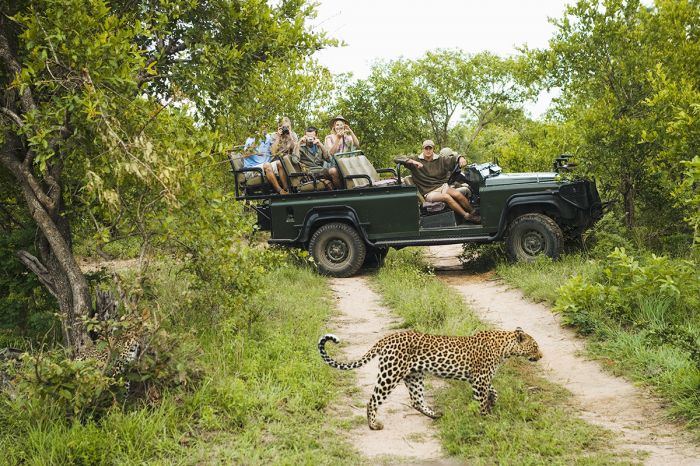
Private reserve game drive and leopard.
Read More...
History, Balule Reserve, Blyde River Canyon, Kapama Reserve, Klaserie Reserve, Makalali Reserve, Manyaleti Reserve, Sabi Sand Reserve, Thornybush Reserve, Timbavati Reserve, Umbabat Reserve
History
In 1926, the Kruger National Park was officially proclaimed as South Africa's first national park. The privately-owned land to the west of Kruger, including the Sabi Sand and other territory was excluded from the new national park and most of this wild bush country was used by the owners for livestock farming or private hunting grounds.
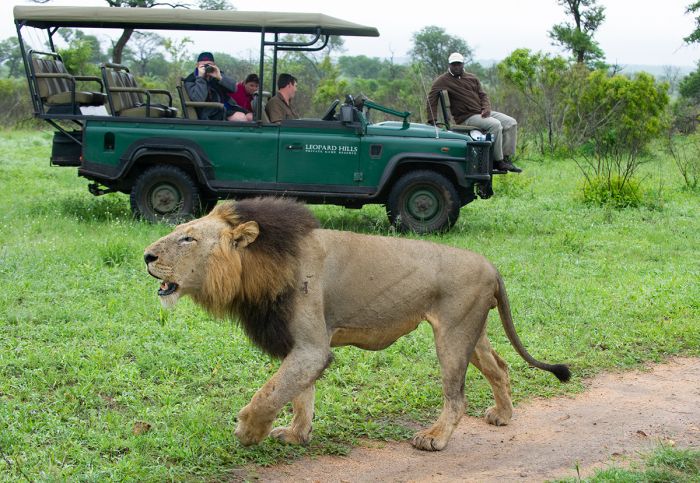
Male lion and game drive in the Sabi Sand Reserve (Copyright © James Weis).
Over the years, some of the landowners to the land west of Kruger organized and combined their lands into private wildlife reserves. The first of these was the Sabi Sand Reserve, which was created in 1948. Several lodges in the newly formed Sabi Sand immediately opened to the public for game viewing.
Further north of the Sabi Sand, more landowners also began organizing into private wildlife reserves and these included the Timbavati, Thornybush, Manyaleti, Klaserie and others.
Today these private wildlife reserves all offer exclusive wildlife safari lodges and privately-guided safaris that rival safaris anywhere in Africa. The reserves are sometimes referred to as The Kruger Private Reserves.
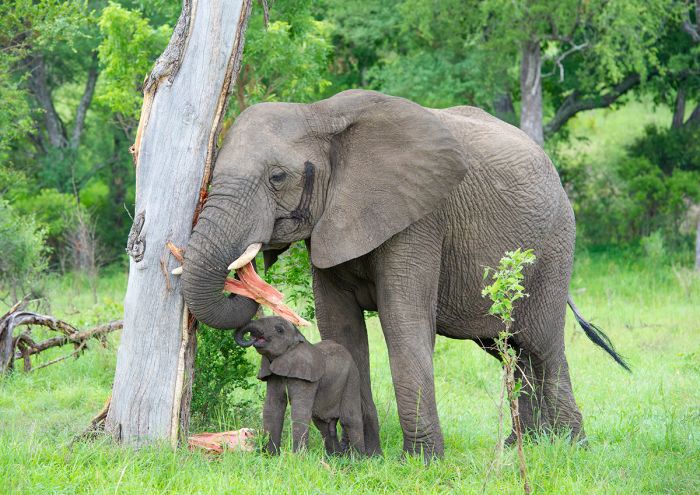
Elephant and her calf in the Sabi Sand (Copyright © James Weis).
Sabi Sand Reserve
Created in 1948, the 240-square-mile (623-sq-km) Sabi Sand Reserve is world famous for its astoundingly good wildlife viewing, and in particular, for its abundance of leopards and the ease with which one can view these beautiful cats. The reserve shares a border with Kruger National Park and is the most visited of the private reserves.
Besides leopards, the Sabi Sand offers near-assurance of seeing the Big Five (lion, leopard, elephant, rhino, buffalo) as well as near non-stop general game viewing and excellent birding. The stellar reputation for excellent safari experiences is well deserved and untold numbers of safari aficionados return to the reserve again and again.
The Sabi Sand offers a wide selection of safari lodges, all of which offer exclusive safaris and world-class guiding. MalaMala, Singita, Londolozi, Ulusaba, and Sabi Sabi are just some of the well-known and established safari lodges in the reserve.
Read full details on the Sabi Sand Game Reserve here.
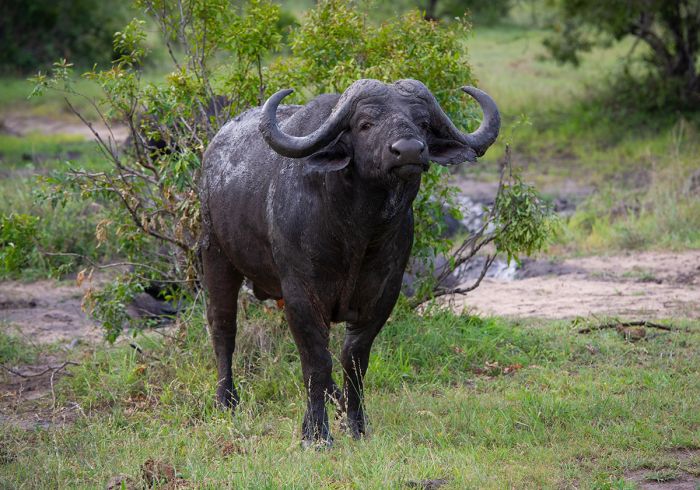
Buffalo seen in the Sabi Sand (Copyright © James Weis).
Timbavati Reserve
The Timbavati Reserve was created in 1956 and covers 289 square miles (748 sq kms) of savanna and woodland. The reserve shares 25 miles (40 kms) of unfenced boundary with Kruger National Park and a total of 69% of its perimeter is bounded by other protected reserves. The Timbavati is similar to the Sabi Sand, but with far fewer lodges that are more spread out and with generally lower prices.
Leopard and rhino viewing do not compare to the Sabi Sand, but the overall game viewing experience is similar and of the private reserves, it is arguably second only to the Sabi Sand when it comes to its wildlife. Elephant, buffalo and all of the regional wildlife are found in abundance here.
Timbavati has also gained fame for its small population of white lions. These lions are not albinos, but rather have blue eyes and their fur color is caused by a recessive gene that sometimes results in cubs of this unique look
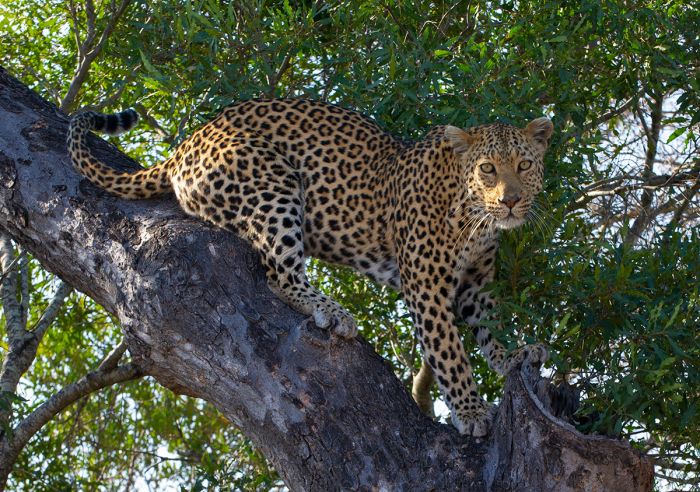
Leopard in the Timbavati Reserve (Copyright © James Weis).
Manyaleti Reserve
Located directly north of the Sabi Sand, the 93-square-mile (240-sq-km) Manyaleti Reserve was created in 1964 and, at the time, was the only private reserve in the country that was open to black visitors. The reserve shares 19 miles (30 kms) of unfenced boundary with Kruger National Park and wildlife viewing here is good.
The reserve is quite underused and there are only a few lodges in the reserve, which gives guests a feeling of exclusivity and you will be unlikely to see many, if any other vehicles during your stay.
All of the big cats are found here, as well as good numbers of general game and seeing all of the Big Five is possible, but finding them is a bit more difficult than in the Sabi Sand or Timbavati.
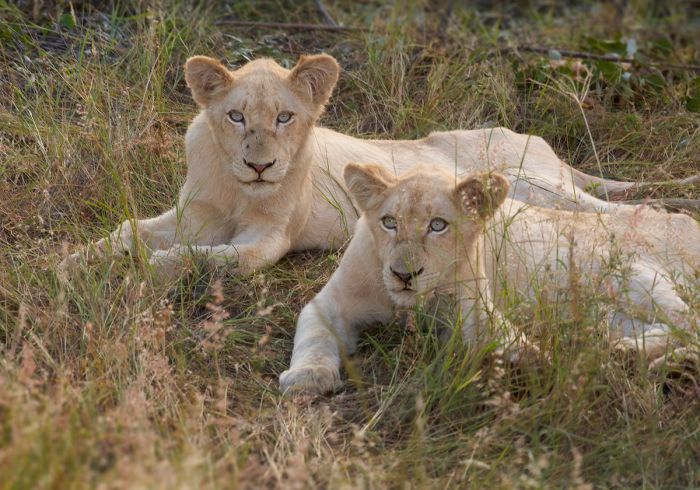
White lions in the Timbavati Reserve.
Thornybush Reserve
Situated on the unfenced western boundary of Timbavati lies the Thornybush Reserve, which covers 54 square miles (140 sq kms) of pristine wilderness. The reserve dates back to 1955. Wildlife viewing is excellent and visitors have a very good chance of seeing all of the Big Five.
The lodges in the reserve are somewhat less luxurious (and generally priced accordingly) than those in the Sabi Sand, but all offer great service, excellent food and a top-notch safari experience
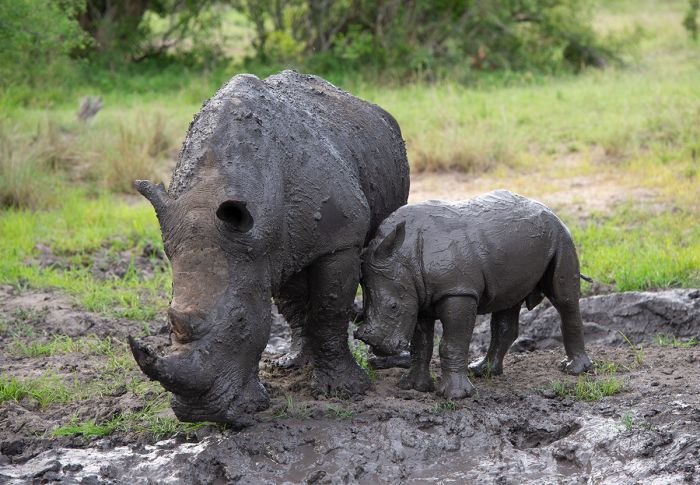
White rhinos enjoying the mud (Copyright © James Weis).
Kapama Reserve
The Kapama Reserve was founded in 1993 and covers 50 square miles (130 sq kms), but unlike the reserves discussed above, it is entirely fenced and not connected to the Kruger National Park, giving it a slightly more contrived feel.
All the Big Five animals are found here and are likely to be seen, as well as an abundance of general game.
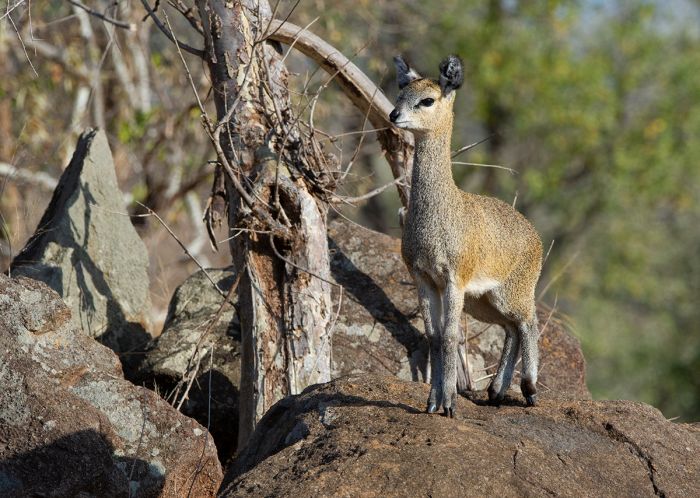
A klipspringer antelope (Copyright © James Weis).
Makalali Reserve
The Makalali Reserve is a 95-square-mile (247-sq-km) wildlife conservancy consisting mostly of savanna grassland, acacia bush and scattered woodlands. The reserve was founded in 1992 and is located west of Kruger National Park, but is not directly connected to the other Kruger reserves.
Makalali has reintroduced a wide variety of indigenous wildlife to the reserve, including lion, cheetah, leopard, rhino, elephant and also the sable antelope.
The reserve is home to all of the Big Five animals and the general game viewing is also very good. The reserve's strong conservation focus and its efforts at protecting and expanding endangered species make it worth visiting if you would like to contribute to their continuing success.
There are several safari lodges located within the reserve.
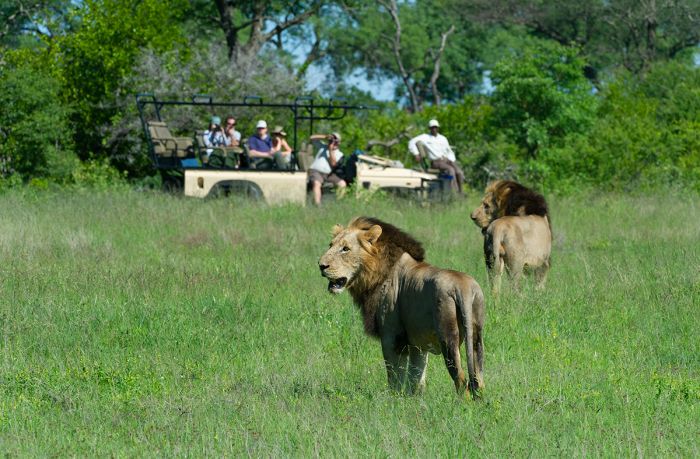
Lions and game drive (Copyright © James Weis).
Klaserie Reserve
Klaserie was proclaimed in 1972 and covers 232 square miles (600 sq kms) of wildlife habitat west of the Timbavati and Umbabat reserves. A number of wildlife research projects are ongoing within the reserve, including "Save the Elephants", which was founded by Dr. Ian Douglas Hamilton and the "Tembo" project, which currently studies buffalo.
The reserve hosts a number of rustic bush camps and safari lodges offering game drives and walking trails. Klaserie is unfenced on its boundaries with Timbavati, Umbabat and Balule reserves and all of Kruger's wildlife are free to move in and out of the reserve. As such, all of the Big Five, plus the myriad general game species of Kruger are seen in Klaserie.
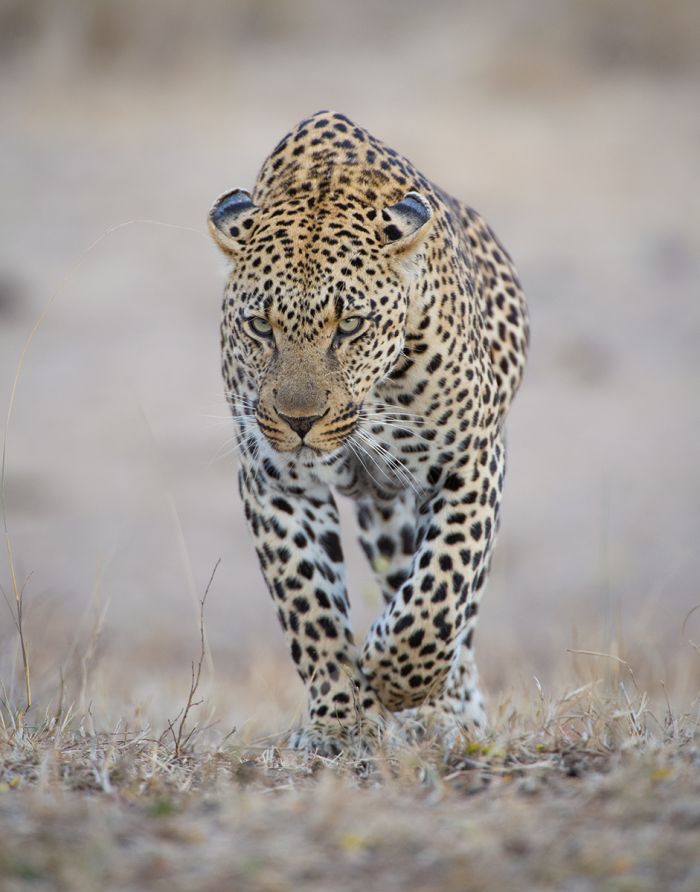
Leopard in the Timbavati Reserve (Copyright © James Weis).
Balule Reserve
As with many of the private reserves, Balule originally consisted of numerous fenced game farms used for hunting. In the early 1990s, these landowners removed all fences and created the Balule reserve. The reserve shares an unfenced boundary with the Klaserie reserve to the east and wildlife from Kruger National park moves freely into the reserve.
All of the Kruger wildlife, including the Big Five are found in Balule. Numerous bush camps and safari lodges are available in Balule.
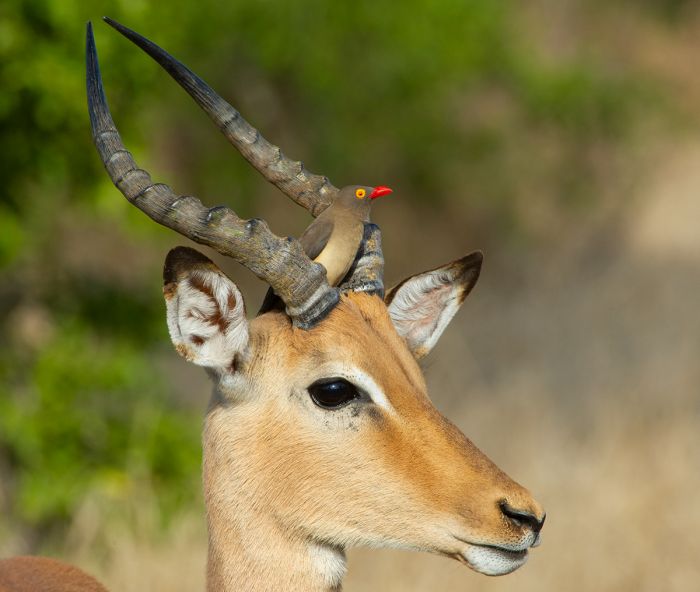
Impala and red-billed oxpecker (Copyright © James Weis).
Umbabat Reserve
Officially proclaimed in 1969, the Umbabat reserve is completely unfenced and bordered on two sides by Kruger National Park and the Timbavati and Klaserie reserves on the others. Wildlife in the reserve is excellent and all of Kruger's wildlife, including the Big Five and all predators and general game are found here in abundance.
Several good safari lodges are located in the reserve.
Blyde River Canyon Nature Reserve
Blyde River is not one of the Kruger private wildlife reserves, but is included here for its proximity to the region.
The Blyde River Canyon is located in the Drakensberg Mountains escarpment and is part of South Africa's famous and historic Panorama Route. The reserve protects the Blyde River Canyon, the world's third largest canyon, featuring numerous waterfalls and geological formations.
The canyon is 16 miles (25 kms) in length north to south, and is on average 2 461 feet (750 meters) in depth.
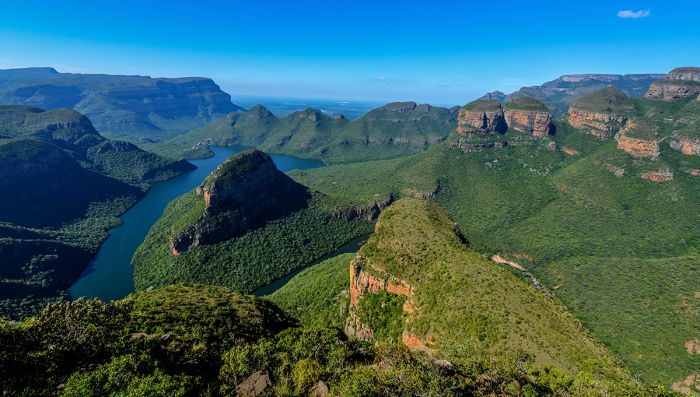
Blyde River Canyon and the Three Rondavels.
Blyde River is wonderful for its panoramic views and includes a multitude of easily accessed visitors' attractions, including Three Rondavels, Bourke's Luck Potholes, God's Window, Lisbon Falls, Berlin Falls, Mac Mac Falls, and others.
The Three Rondavels are a series of grass-covered mountainous rock protrusions that resemble traditional round or oval-shaped African homesteads, called rondavels. On clear days, the lookout point gives incredible vistas over the canyon and to the three rondavels on the other side and further to various promontories of the Drakensberg mountain range.
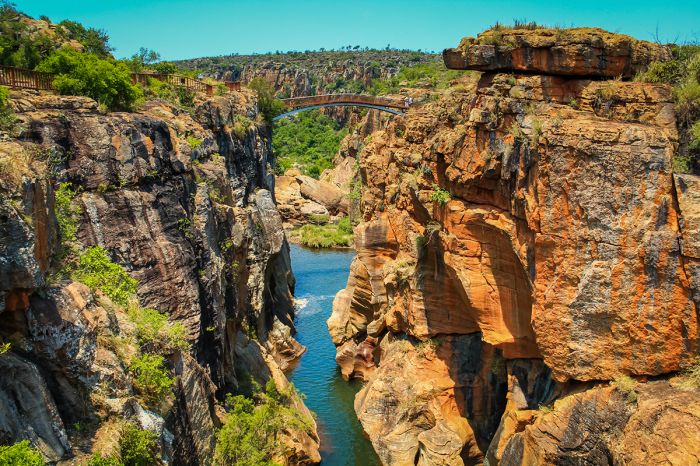
View of the Blyde River Canyon at Bourke's Luck Potholes.
Bourke's Luck Potholes are a unique geological feature formed by swirling waters at the confluence of the Blyde and Truer rivers. Over time, these waters created numerous huge cylindrical 'potholes' in the sandstone. Viewed from above, the effect is a fascinating collection of tubes, tunnels and interconnected swirling pools of water, each different from the next. Bridges and viewing platforms allow visitors to photograph the formations from different angles and there are some short walking trails.
God's Window is another popular viewpoint over the Drakensberg escarpment at the for south of the reserve. The vistas here are of steep cliffs that rise up 700 meters (2 300 feet) from the plains and forests of the lowveld. The incredibly scenic view gives its name and on clear days, one can see all the way to Kruger National Park and the Lebombo Mountains on the Mozambique border.
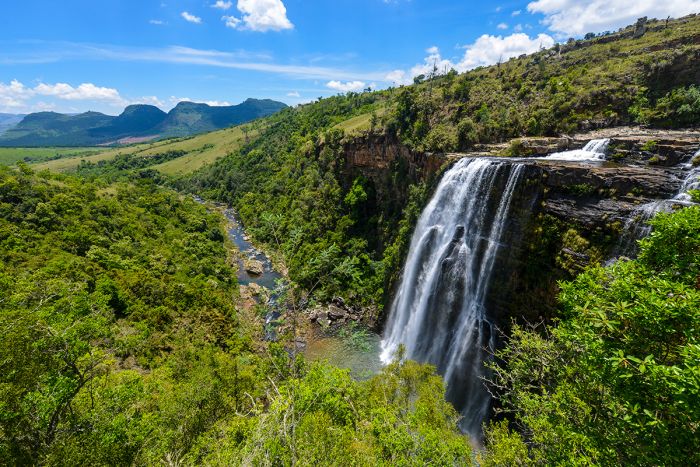
Lisbon Falls in the Blyde River Canyon.
Wildlife in the reserve includes baboon, mountain reedbuck, greater kudu, wildebeest, impala, zebra and waterbuck. There are crocodiles and hippos in the Blyderivierpoort Dam. Birding in the reserve is excellent, with eagles and other raptors, sunbirds, cuckoos, woodpeckers, Lourdes and many more.
The flora inside the reserve is also noteworthy due to the diverse habitats including grassland plateau, wetland, riparian forest, afromontane forest, dry and moist woodland, grassy slopes, and more. More than 1,000 species of plant have been recorded including the Blyde river cycad, various orchids and proteas.
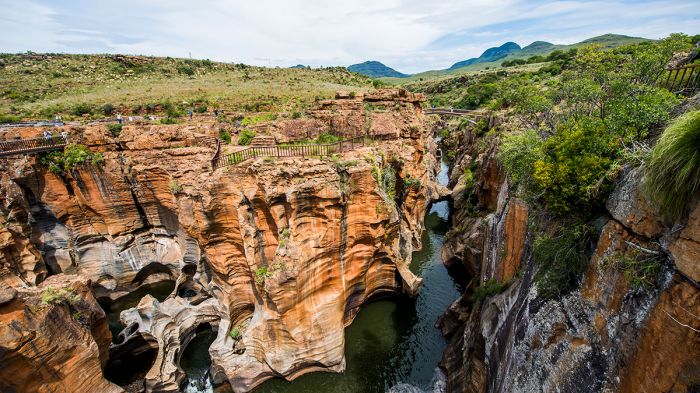
Bourke's Luck Potholes in the Blyde River Canyon.
Read More...
History, Balule Reserve, Blyde River Canyon, Kapama Reserve, Klaserie Reserve, Makalali Reserve, Manyaleti Reserve, Sabi Sand Reserve, Thornybush Reserve, Timbavati Reserve, Umbabat Reserve
Great Good Fair Poor
- Jan
- Feb
- Mar
- Apr
- May
- Jun
- Jul
- Aug
- Sep
- Oct
- Nov
- Dec
The private reserves near Kruger National Park offer year-round wildlife viewing. The animals here do not migrate away from the region, although they do move between the various reserves and the national park. Most of the reserves are connected to Kruger National Park by unfenced boundaries, which allows the animals to move freely within this large wilderness habitat.
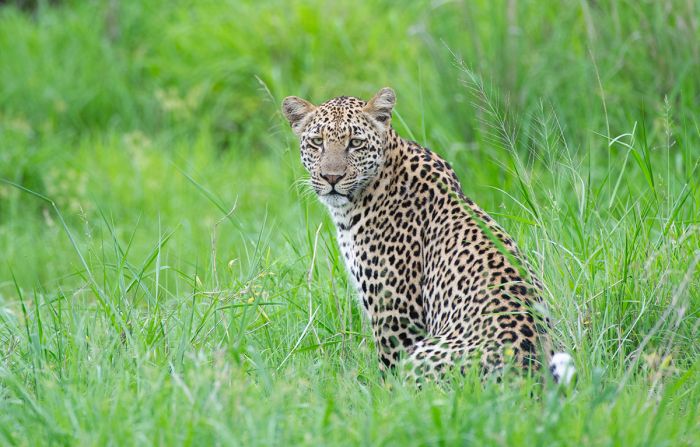
A leopard in summer (Copyright © James Weis).
The summer months are warm and humid and the rains fall between November and March. The heaviest rains fall between December and March, and these may interfere with game viewing when they set in and especially in years with heavier rainfall.
The winter months are cool and dry and generally speaking, wildlife can be easier to find as the water availability in the bush is reduced and the wildlife is more likely to be seen along the permanent rivers or at pumped waterholes.
SUMMER AND RAINS
Spring and summer is the green season and the landscape transforms from the dry and dusty browns of winter into a verdant paradise after the first few rains, usually sometime in late October or early November.
Wildlife viewing is very good and the photography is superb, with rich colors and dramatic skies. There are also more baby animals (like impalas) being born to herbivores during the green season to take advantage of the fresh new vegetation.
The heaviest rains fall in January and February and the air becomes humid and hot.
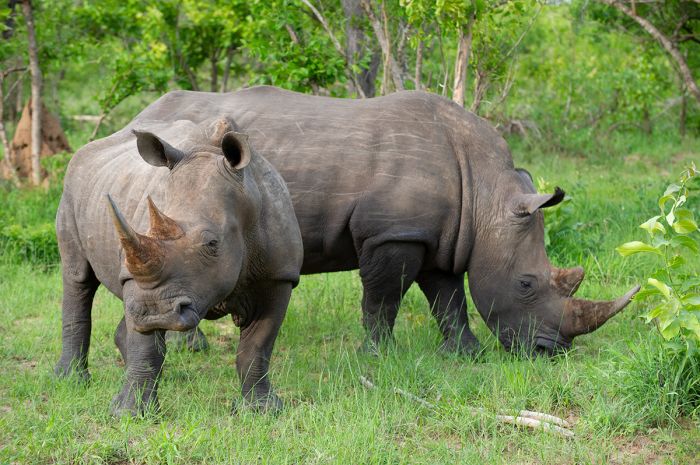
White rhinos seen during the green summer season.
The early rains begin with afternoon showers in late October or early November. The frequency of showers gradually increases as the days progress. Mornings average 64°F/18°C and climb to 86°F/30°C in the mid-afternoon. These springtime months are truly lovely, with new greenery covering the land and thousands of birds returning from the wintering grounds to breed. Wildlife viewing is very good.
December thru February bring much warmer temperatures and the humidity is high. Afternoons are generally hot at around 88°F/31°C but can reach 104°F./40°C on some days. The landscape is fresh and green, trees are in full bloom, flowers carpet the plains and photographers will find lovely imaging at every turn. Many of the herbivores have given birth and the landscape is teeming with new life. Predators are reaping the bounty.
The rains are abating by March and April, but occasional showers are still probable every few days. The days are gradually becoming cooler, averaging a comfortable 84°F/29°C and dropping to 64°F/18°C overnight. The vegetation is heavy and animals may be more difficulty to spot. The migrant birds are starting to move back north for the coming winter.
WINTER / DRY SEASON
The winter months are cool are dry and the game viewing is very good, getting progressively better as the rainwater in the pans evaporates and animals spend more time at or near the permanent waterways and pumped waterholes.
Game drives in the open vehicles require warmer clothing and it is best to wear multiple layers so that as they day progresses and temperatures warm up, one can shed a layer or two.
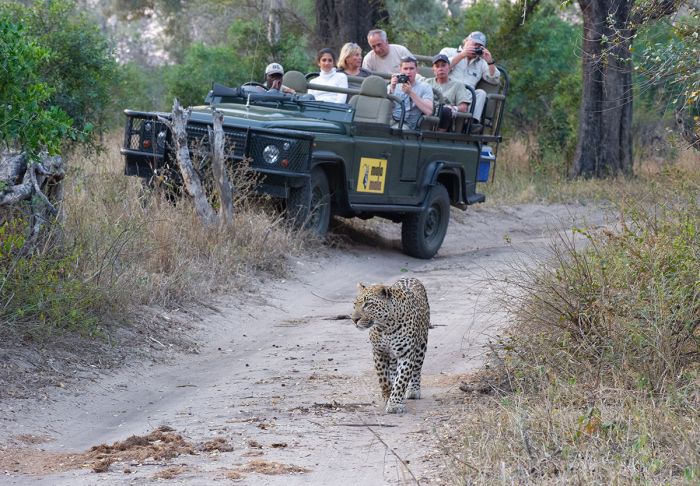
Leopard and game drive in August (Copyright © James Weis).
May marks the end of fall and the beginning of winter, with mornings around 54°F/12°C and afternoons climbing to 79°F/26°C and rainfall has ended.
June thru August are the middle of winter and rainfall is very rare. Mornings are quite chilly, averaging 48°F/9°C. The afternoons are clear and sunny, averaging 77°F/25°C. Wildlife viewing is excellent, with animals tending to congregate along the waterways and at the permanent water holes.
September is one of the best months in terms of game viewing and comfortable air temperature. Rain is rare to non-existent. Days are lovely and comfortable, averaging 82°F/28°C in the afternoons and a comfortable 57°F/14°C in the mornings. September is usually the busiest month in terms of tourists and most safari lodges are fully booked far in advance.
Showing 1–2 of 2 results
Located in the Timbavati Reserve, which shares an unfenced border with Kruger National Park. Outstanding wildlife viewing, including all of Africa's Big Five animals, in a massive, exclusive-use land concession with just two lodges.…




